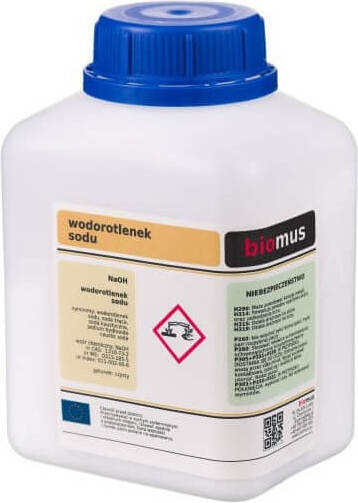Sodium hydroxide, caustic soda, granules 250g BIOMUS
- Regular price
- €4,72
- Regular price
-
- Sale price
- €4,72
- Unit price
- per
Couldn't load pickup availability
Description
xDESCRIPTION
Sodium hydroxide granules 250 g BIOMUS
- participates in the manufacture of soap, glass, rubber
-as a component of drain cleaning products
-used as an acidity regulator
Sodium hydroxide can be found under the names: caustic soda, caustic soda, caustic soda, caustic soda
Solid caustic soda is a white crystalline substance. It is hygroscopic and easily combines with carbon dioxide in the air (forming a sodium carbonate coating). Store it in tightly closed jars. It dissolves very well in water, liberates significant amounts of heat and forms caustic soda, that is, an odorless, colorless, non-flammable liquid that reacts with acids, nonmetal oxides and amphoteric hydroxides, forming sodium salts. It feels slippery and causes burns. It is corrosive to metals, especially in the presence of moisture. It readily reacts with metals with amphoteric properties to release hydrogen (e.g. with aluminum and zirconium to form clay and zirconates, respectively). Forms salts with weak organic acids (e.g. phenols and nitromethane). Under the influence of NaOH, nonmetals disproportionate (for example, white phosphorus boiled with NaOH solution gives phosphate and phosphate, and sulfur dissolves in NaOH solution to form sulfide and sulfite).
INGREDIENTS
sodium hydroxide (caustic soda)
Chemical formula: NaOH
Species: pure
Purity: min 98.5%
APPLICATION
Caustic soda is used as a component of preparations for cleaning sewage pipes. It is also involved in the manufacture of soap, fused silica, dyes and rayon. In addition, it is used in rubber manufacture, water treatment for industrial purposes and in the paper industry.
RECOMMENDED STORAGE CONDITIONS
Dry, dark and cool place. Keep out of reach of children.
similar products
- Regular price
- €4,72
- Regular price
-
- Sale price
- €4,72
- Unit price
- per
- Regular price
- €4,72
- Regular price
-
- Sale price
- €4,72
- Unit price
- per
- Regular price
- €4,72
- Regular price
-
- Sale price
- €4,72
- Unit price
- per
- Regular price
- €4,72
- Regular price
-
- Sale price
- €4,72
- Unit price
- per
- Regular price
- €4,72
- Regular price
-
- Sale price
- €4,72
- Unit price
- per
- Regular price
- €4,72
- Regular price
-
- Sale price
- €4,72
- Unit price
- per
- Regular price
- €4,72
- Regular price
-
- Sale price
- €4,72
- Unit price
- per
- Regular price
- €4,72
- Regular price
-
- Sale price
- €4,72
- Unit price
- per
- Regular price
- €4,72
- Regular price
-
- Sale price
- €4,72
- Unit price
- per
- Regular price
- €4,72
- Regular price
-
- Sale price
- €4,72
- Unit price
- per
Recently Viewed Products
- Regular price
- €4,72
- Regular price
-
- Sale price
- €4,72
- Unit price
- per
- Regular price
- €4,72
- Regular price
-
- Sale price
- €4,72
- Unit price
- per
- Regular price
- €4,72
- Regular price
-
- Sale price
- €4,72
- Unit price
- per
- Regular price
- €4,72
- Regular price
-
- Sale price
- €4,72
- Unit price
- per
- Regular price
- €4,72
- Regular price
-
- Sale price
- €4,72
- Unit price
- per
- Regular price
- €4,72
- Regular price
-
- Sale price
- €4,72
- Unit price
- per
- Regular price
- €4,72
- Regular price
-
- Sale price
- €4,72
- Unit price
- per
- Regular price
- €4,72
- Regular price
-
- Sale price
- €4,72
- Unit price
- per
- Regular price
- €4,72
- Regular price
-
- Sale price
- €4,72
- Unit price
- per
- Regular price
- €4,72
- Regular price
-
- Sale price
- €4,72
- Unit price
- per
- Choosing a selection results in a full page refresh.















